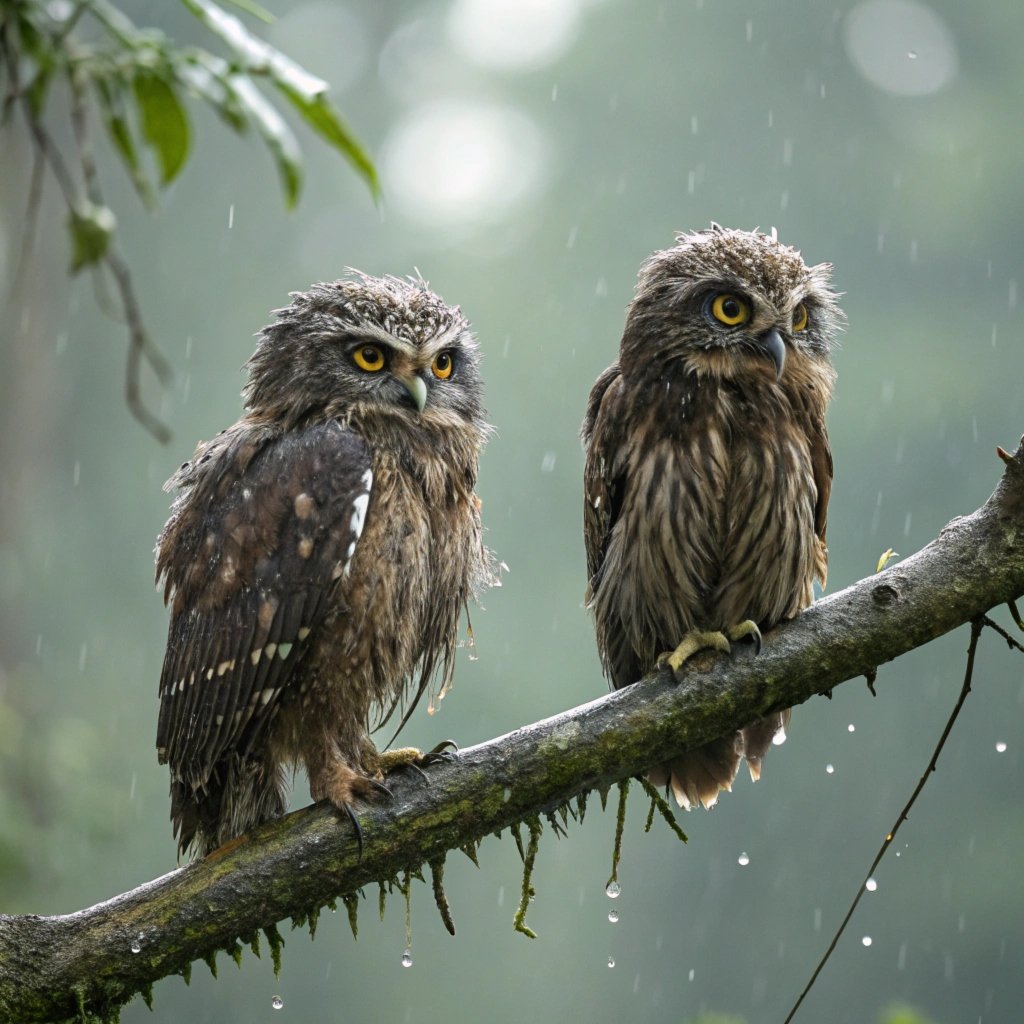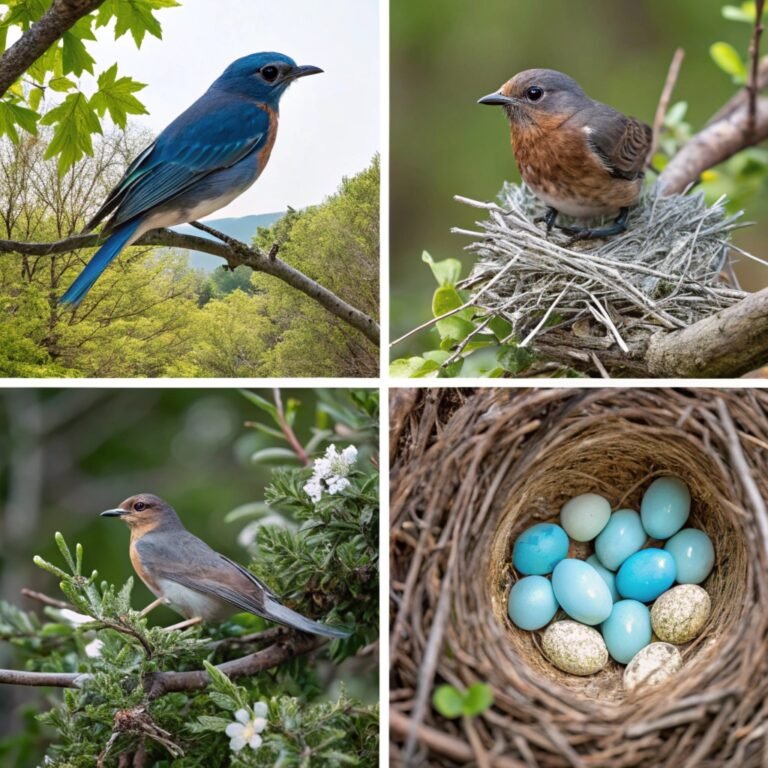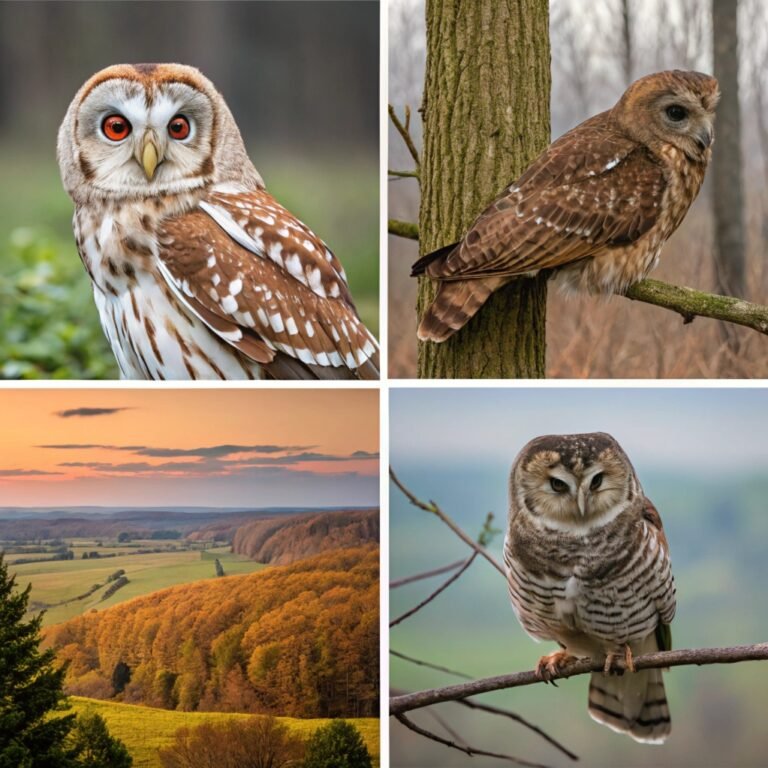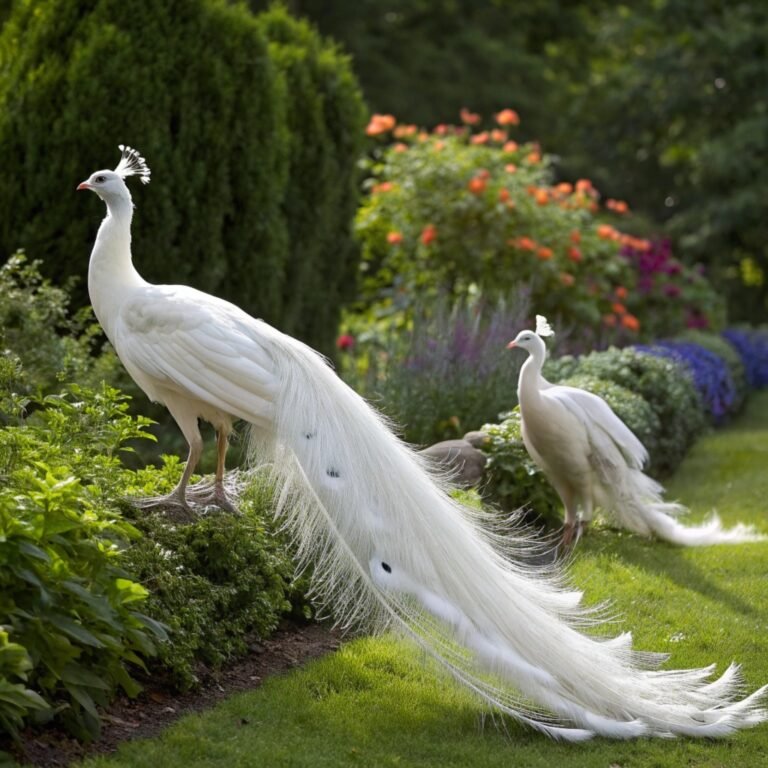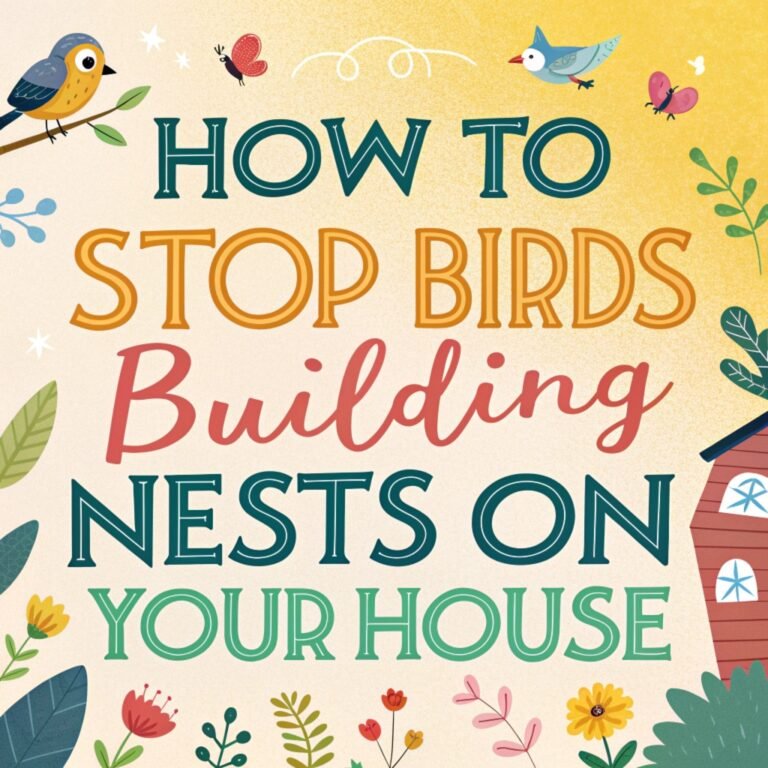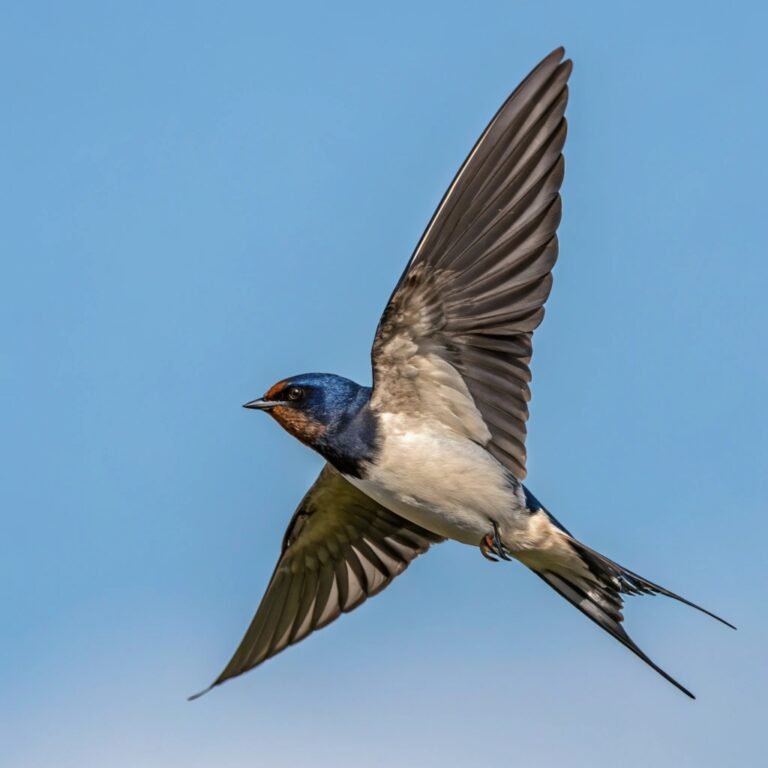Wet Owls Symbolisms: Amazing Adaptations and Challenges of Owls in Rainy and Wet Conditions
Owls are remarkable creatures, known for their silent flight and exceptional hunting abilities.
However, when faced with wet conditions, these majestic birds encounter significant challenges.
This comprehensive guide delves into the fascinating world of wet owls, exploring their behavior, adaptations, and the unique difficulties they face in rainy weather.

Key Takeaways:
- Owls have specialized feathers for silent flight, but these are more susceptible to water absorption, making them less water-resistant than other birds.
- Wet conditions significantly impair an owl’s ability to hunt, fly, and regulate body temperature.
- Owl feathers lack the oil found in many other birds‘ feathers, making them more vulnerable to getting waterlogged.
- When wet, owls lose their buoyancy and appear smaller as water flattens their usually voluminous plumage.
- Wet feathers reduce an owl’s flight efficiency, increasing drag and making it harder to maneuver.
- Most owl species avoid flying or hunting when wet, often seeking shelter during rainy periods.
- Owls may fluff up their feathers to trap air between their skin and feathers, helping them stay warmer and somewhat drier.
- Prolonged exposure to wet conditions can be life-threatening for owls due to hypothermia and reduced hunting success.
- Different owl species have varying levels of adaptation to wet conditions, with some forest-dwelling species being better equipped than others.
- Barn Owls are particularly vulnerable to rainfall, as their hunting style in long grass can lead to easily waterlogged feathers.
- Some owls, like Burrowing Owls, may actually enjoy rain showers, possibly using them as an opportunity to rinse their feathers and remove parasites.
- Wet weather can significantly impact owl breeding success by affecting hunting ability and nest conditions.
- Conservation efforts should consider the challenges faced by owls in wet conditions, including the preservation of diverse habitats with adequate shelter options.
The Unique Physiology of Owls: A Double-Edged Sword in Wet Conditions
Owls possess extraordinary anatomical features that make them exceptional hunters in dry conditions. Their specialized feathers, designed for silent flight, are a marvel of nature.
However, these same adaptations can become a liability when exposed to rain. The soft, fringed edges of owl feathers, which normally reduce turbulence and noise during flight, are more susceptible to water absorption.
This vulnerability can lead to waterlogged feathers, significantly impairing an owl’s ability to fly efficiently.
Additionally, owls have larger bodies relative to their wingspan compared to other birds, which aids in balance and energy conservation during dry flights.
However, when wet, this body structure can become a disadvantage, making it more challenging for owls to maintain their usual grace and agility in the air.
Owls, renowned for their silent flight and exceptional hunting prowess, face significant challenges when confronted with wet conditions.
These majestic birds, adapted for nocturnal predation, find their specialized features becoming liabilities in rainy weather.
The unique structure of owl feathers, designed for noiseless movement through the air, becomes a double-edged sword when exposed to moisture.
The Impact of Wet Feathers on Owl Flight and Hunting

When an owl’s feathers become saturated with water, it experiences a dramatic decrease in flight efficiency.
The increased weight and drag caused by wet feathers make it difficult for owls to maneuver with their usual precision. This reduction in flight capabilities has a direct impact on their hunting success.
Owls rely heavily on their ability to fly silently and swiftly to catch prey unawares. In wet conditions, their movements become more labored and noisy, alerting potential prey to their presence.
The friction caused by wet feathers not only produces sound but also reduces the owl’s stability in the air.
As a result, wet owls often find themselves at a significant disadvantage when attempting to hunt, leading to potential food scarcity during prolonged periods of wet weather.
Unlike many other birds, owls lack the oil-producing glands that help waterproof feathers, making them particularly vulnerable to saturation.
When an owl’s plumage becomes waterlogged, it loses its ability to trap air effectively, compromising both insulation and flight efficiency.
This can lead to a cascade of problems for the bird, affecting everything from its hunting success to its very survival.
The impact of wet conditions on owls extends far beyond mere discomfort. A wet owl experiences a dramatic decrease in its hunting capabilities, which are crucial for its survival.
Thermoregulation Challenges for Wet Owls
Owls are well-adapted to cold environments, with their dense plumage providing excellent insulation against chilly night air.
However, this adaptation becomes problematic when their feathers are soaked. Wet feathers lose much of their insulating properties, making it difficult for owls to maintain their body temperature, especially in colder weather.
Unlike some other birds that can effectively shake off water, owls are not particularly adept at this skill.
This inability to quickly dry themselves puts them at risk of hypothermia during extended exposure to wet conditions.
As a result, wet owls often seek shelter and remain inactive for long periods, waiting for their feathers to dry naturally, which can take considerable time.
The added weight of water-soaked feathers makes flight more laborious and less precise, while the loss of silent movement alerts potential prey to the owl’s presence.
This reduction in hunting efficiency can lead to food scarcity, particularly problematic during breeding seasons when owls need to provide for their young.
Moreover, the loss of insulation due to wet feathers poses a serious risk of hypothermia, especially in colder climates or during extended periods of rainfall.
Different owl species exhibit varying levels of adaptation to wet conditions, reflecting their native habitats and evolutionary history.
Behavioral Adaptations of Owls in Rainy Weather
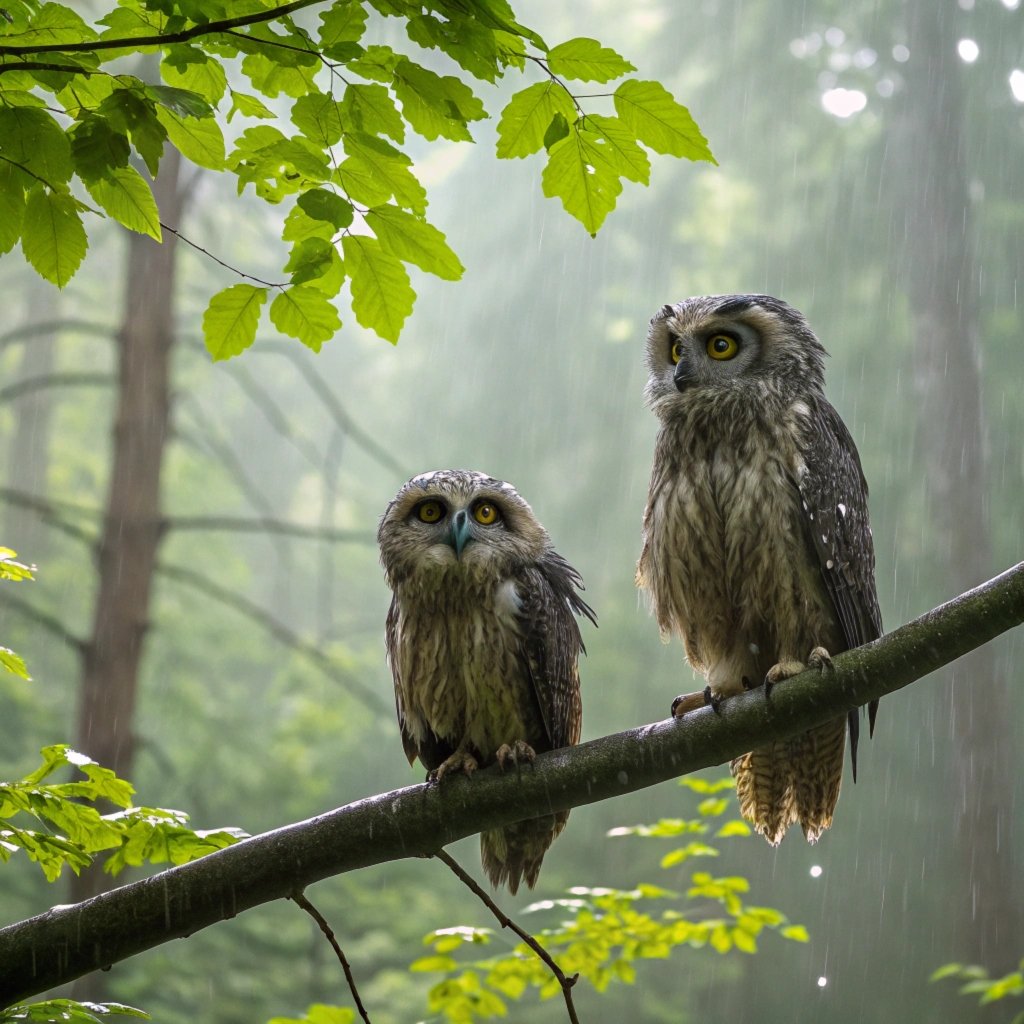
When faced with rainy conditions, owls exhibit specific behavioral adaptations to cope with the challenges.
Most owl species will actively seek shelter at the onset of rain, much like humans do during inclement weather.
They often find refuge in the thick branches of trees, within caves, or in other protected areas.
In these safe spots, owls will wait out the rain, occasionally grooming and shaking off water in an attempt to dry their feathers.
Owls are known to fluff up their feathers, trapping air between their skin and feathers, which helps them stay warmer and somewhat drier.
However, this behavior is not a perfect solution, and prolonged rainfall can still lead to thoroughly soaked feathers and cold conditions for the bird.
Forest-dwelling species like the Tawny Owl often show better resilience to damp environments, benefiting from the shelter provided by dense canopies.
In contrast, open-habitat species such as the Barn Owl are particularly susceptible to the challenges posed by rain, with their hunting style in long grass leading to easily waterlogged feathers.
Some owls, like the Burrowing Owl, have been observed to seemingly enjoy light rain showers, possibly using them as an opportunity to cleanse their feathers and remove parasites.
The long-term implications of increasing rainfall patterns due to climate change could have profound effects on owl populations.
The Silent Hunter’s Dilemma: Acoustic Challenges in Wet Conditions
Owls are renowned for their exceptional hearing, which plays a crucial role in their hunting strategy. However, rainy conditions pose significant challenges to their acoustic abilities.
The sound of raindrops hitting surfaces creates background noise that can mask the subtle sounds made by potential prey.
This interference makes it much more difficult for owls to locate and track their targets accurately.
Additionally, wet ground conditions can dampen the sounds typically produced by small mammals moving through vegetation, further complicating the owl’s hunting process.
As a result, owls may need to rely more heavily on visual cues during wet weather, which can be challenging in low-light conditions or heavy rainfall.
More frequent and intense precipitation events may lead to reduced breeding success, altered distribution patterns, and potentially population declines in some species.
Nesting and Reproduction: The Impact of Wet Weather on Owl Families
Wet weather can have a substantial impact on owl nesting and reproduction. Prolonged periods of rain can lead to nest flooding, particularly for species that nest in tree cavities or on the ground.
This can result in the loss of eggs or young chicks. Additionally, the reduced hunting success during wet conditions can lead to food shortages for breeding pairs and their offspring.
Parent owls may struggle to provide enough food for their growing chicks, potentially leading to reduced survival rates among young owls.
Some owl species may delay breeding or reduce clutch sizes in response to prolonged wet weather, as an adaptive strategy to increase the chances of successful reproduction under challenging conditions.
Conservation efforts must take these factors into account, focusing on preserving diverse habitats that offer adequate shelter options for owls during wet periods.
Additionally, the installation of properly designed nest boxes and the maintenance of natural roosting sites can provide crucial refuges for owls in areas prone to frequent rainfall.
Species-Specific Responses to Wet Conditions: A Comparative Analysis
Different owl species exhibit varying levels of adaptation to wet conditions. For instance, Barn Owls (Tyto alba) are particularly vulnerable to rain due to their less water-resistant feathers.
They often cease hunting activities during heavy rainfall and may face significant challenges in maintaining their population during prolonged wet periods.
In contrast, some forest-dwelling owl species, such as the Tawny Owl (Strix aluco), show slightly better adaptations to damp environments, although they still face challenges in heavy rain.
Wetland-adapted species like the Short-eared Owl (Asio flammeus) demonstrate greater resilience to wet conditions, but even they have limits to their tolerance of prolonged exposure to rain.
The Role of Habitat in Mitigating Wet Weather Challenges for Owls
The type of habitat an owl inhabits can play a significant role in how well it copes with wet conditions.
Owls living in forested areas often have more options for finding shelter during rainy periods, utilizing dense canopies and tree cavities for protection.
In contrast, owls inhabiting open grasslands or agricultural areas may face greater challenges in finding adequate shelter from the rain.
The availability of suitable roosting sites that offer protection from the elements can be crucial for owl survival during extended periods of wet weather.
Conservation efforts aimed at preserving diverse habitats with ample shelter options can significantly benefit owl populations in regions prone to frequent rainfall.
Seasonal Variations: How Different Weather Patterns Affect Owl Behavior
Owl behavior and adaptations to wet conditions can vary significantly depending on the season.
During the breeding season, owls may be more likely to endure wet conditions to continue hunting and providing for their offspring.
In contrast, during non-breeding periods, they might be more inclined to seek shelter and conserve energy when faced with rain.
Seasonal changes in prey availability and vegetation cover also influence how owls respond to wet weather.
For example, in seasons with abundant prey, owls might be better equipped to withstand short periods of unfavorable weather, whereas during leaner times, even brief rainy spells could pose significant challenges to their survival.
The Long-Term Effects of Climate Change on Owl Populations
Climate change is leading to alterations in weather patterns, including changes in the frequency and intensity of rainfall in many regions.
These shifts can have profound long-term effects on owl populations. Increased occurrences of extreme weather events, such as prolonged rainy periods or severe storms, can negatively impact owl breeding success and survival rates.
Changes in precipitation patterns can also affect the availability and distribution of prey species, indirectly influencing owl populations.
Some owl species may need to adapt their range or behavior in response to these changing conditions, while others may face declining populations in areas that become unsuitable due to altered weather patterns.
Conservation Strategies for Protecting Owls in Wet Environments
Conservation efforts aimed at protecting owls in wet environments are crucial for ensuring the long-term survival of these species.
Key strategies include the preservation and restoration of diverse habitats that provide adequate shelter options for owls during wet weather.
This can involve maintaining old-growth forests with natural tree cavities, as well as installing artificial nest boxes in areas where natural nesting sites are limited.
Additionally, conservation programs can focus on educating the public about the challenges faced by owls during wet conditions and promoting practices that minimize human disturbance to owl habitats during critical periods.
Research into the specific needs of different owl species in wet environments can also inform more targeted conservation efforts.
Technological Advancements in Studying Wet Owl Behavior
Recent technological advancements have greatly enhanced our ability to study owl behavior in wet conditions.
GPS tracking devices and miniature weather sensors attached to owls allow researchers to gather detailed data on their movements and the environmental conditions they encounter.
Infrared and night-vision cameras enable scientists to observe owl behavior during rainy nights without disturbing the birds.
These technologies provide valuable insights into how different owl species cope with wet conditions, their shelter-seeking behaviors, and the impact of rain on their hunting success.
Such data is crucial for developing effective conservation strategies and understanding the long-term effects of changing weather patterns on owl populations.
Human Interactions: How We Can Help Wet Owls
There are several ways in which humans can assist owls during wet weather conditions. Installing properly designed nest boxes can provide crucial shelter for owls, especially in areas where natural nesting sites are scarce.
These boxes should be waterproof and positioned to minimize exposure to prevailing winds and rain.
Additionally, maintaining diverse habitats with a variety of vegetation types can offer owls more options for finding natural shelter.
In agricultural areas, preserving hedgerows and small wooded areas can provide important refuges for owls during wet weather.
Reducing the use of rodenticides, especially during rainy periods when owls may be more desperate for food, can help ensure a safer food supply for these birds when they are most vulnerable.
FAQs
How long can an owl survive in wet conditions?
The survival time of an owl in wet conditions varies depending on the species, the severity of the weather, and the availability of shelter. Generally, owls can endure short periods of rain, but prolonged exposure to wet conditions can be life-threatening due to hypothermia and reduced hunting success.
Do all owl species react the same way to rain?
No, different owl species have varying levels of adaptation to wet conditions. Some forest-dwelling species may be better equipped to handle damp environments, while others, like Barn Owls, are particularly vulnerable to rain due to their less water-resistant feathers.
Can wet owls still hunt effectively?
Wet owls face significant challenges in hunting effectively. Their waterlogged feathers reduce flight efficiency and increase noise, making it harder to approach prey silently. Additionally, rain can interfere with their ability to hear prey movements accurately.
How do owls dry themselves after getting wet?
Owls primarily dry themselves by seeking shelter and allowing their feathers to dry naturally. They may also fluff up their feathers to trap air and promote drying. Unlike some birds, owls are not particularly adept at shaking off water.
Does wet weather affect owl breeding success?
Yes, prolonged wet weather can negatively impact owl breeding success. It can lead to nest flooding, reduced hunting success, and difficulties in providing enough food for growing chicks, potentially resulting in lower survival rates for young owls.

Hello, I’m Emily Price, the founder of Birds Affection. As a passionate bird enthusiast and spiritual seeker, I’ve always been fascinated by the symbolic meanings and mystical connections between birds and our lives. On this website, I share my knowledge and insights on the spiritual significance of various bird species, exploring their roles as messengers, guides, and teachers. Through my writing, I aim to inspire and educate others on the profound wisdom and beauty that birds bring to our world. Join me on this journey as we delve into the enchanting realm of bird symbolism and discover the hidden meanings behind these magnificent creatures.

